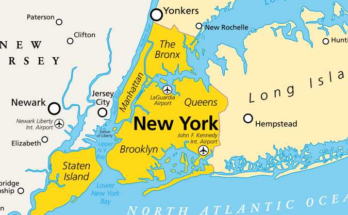The history of New York is a remarkable story of transformation, marked by its rise from indigenous lands to one of the world’s most influential cities.
Pre-Colonial Era
For thousands of years before European exploration, New York was home to diverse Native American tribes. The Lenape occupied the southern part of the region, while the Iroquois Confederacy (Haudenosaunee) dominated the central and northern areas. These groups lived in organized communities, practicing agriculture, hunting, and fishing. The Iroquois Confederacy, known for its sophisticated political system, played a crucial role in the region’s development before European contact.
Colonial Period
In 1609, English explorer Henry Hudson, working for the Dutch East India Company, sailed up the river that now bears his name, sparking European interest. The Dutch established a fur trading post near Albany in 1614 and founded New Amsterdam on Manhattan Island in 1624. New Amsterdam became a vibrant settlement, attracting settlers from diverse backgrounds.
In 1664, the English seized the colony, renaming it New York after the Duke of York. Under English rule, New York grew into an important trading hub. The city’s strategic location made it a center for commerce and immigration, setting the stage for its future growth.
Revolutionary War and Independence
During the American Revolution, New York played a pivotal role. The city was a major battleground and the site of several significant events, including the Battle of Long Island in 1776. After a period of British occupation, New York emerged as a symbol of resilience and liberty. In 1789, it became the first capital of the United States, and George Washington was inaugurated as the nation’s first president on Wall Street.
19th Century Growth
The 19th century was a transformative period for New York. The completion of the Erie Canal in 1825 connected the Great Lakes to the Atlantic Ocean, solidifying New York City’s position as a trade and transportation hub. Immigrants, particularly from Ireland and Germany, poured into the city, shaping its cultural and social fabric. By the late 1800s, New York was a global financial and industrial center. Iconic structures like the Statue of Liberty (dedicated in 1886) symbolized the city’s role as a gateway for millions seeking a better life.
20th Century to Present
In the 20th century, New York solidified its status as a cultural, financial, and political powerhouse. The construction of skyscrapers like the Empire State Building and landmarks like Times Square defined its skyline. During this time, the city became a hub for art, theater, and innovation.
Tragedies such as the September 11, 2001, attacks tested the city’s resilience, but New Yorkers demonstrated their indomitable spirit. Today, New York remains a global leader in finance, culture, and diplomacy, hosting the United Nations and serving as a symbol of diversity and opportunity.
From its indigenous roots to its global prominence, New York’s history is a testament to the enduring power of transformation and resilience.


